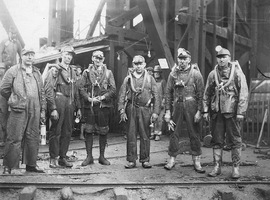
In the late 1800s and early 1900s, West Virginia became one of the country’s major coal-producing states. As coal production increased, so did the number of explosions and deaths. Mining accidents claimed thousands of lives annually throughout the nation. Most coal operations neglected basic safety precautions. The prevailing sentiment, especially among those in power, was that miner carelessness was at the core of mine accidents, and that casualties were an inevitable price of rapid industrialization. West Virginia had one of the worst records for safety and health protection in the nation, and the state’s mining law, passed in 1887, was regarded by many as the nation’s weakest.
In 1905, the West Virginia Department of Mines was created. Following a series of small mining disasters, sentiment slowly began to change. West Virginia’s chief mine inspector called for more and better-trained inspectors who would have greater authority to shut down mines operating outside the law.
Governor Dawson appointed a commission of miners and mine operators to review current industry conditions and draft a bill that would address key safety issues. In February 1907, a substantial revision of West Virginia’s mine safety laws was passed. This new law charged mine foremen with instructing inexperienced miners and conducting frequent mine examinations, but still was less stringent than in some other states.
Meanwhile, mine disasters continued unabated. In December 1907, a massive explosion ripped through the Fairmont Coal Company’s No. 6 and 8 mines in Monongah, killing at least 361 people in the single worst mining disaster in U.S. history.
Congress faced pressure to study mining conditions and create uniformity among states with regard to setting higher standards for mining conditions. Some believed that federal regulation was driven not by concern for miners but by a desire to fend off state-by-state legislation that might jeopardize local competitiveness. In West Virginia, the legislature rejected every mine safety law proposed in 1908 and passed no major safety legislation for the next seven years. By 1915, legislation brought some substantial improvements, calling for provisions for preventing underground mine fires and requiring foremen and fire bosses to pass state examinations and receive state certification.
Nationally, mine safety came under closer scrutiny. In 1908, President Theodore Roosevelt advocated the formation of a federal agency to investigate mine accidents, teach accident prevention, and conduct mine safety research. Two years later, the U.S. Bureau of Mines was formed.
Although mine deaths decreased dramatically during the next several decades, too many miners continued to die needlessly in mining accidents. The next turning point came in 1968, when 78 miners died in a fire at a Farmington coal mine. This event jolted the mining community and helped trigger the passage of sweeping federal legislation. Miners rallied together, marching on the West Virginia state capitol and on Washington, demanding that Congress take action. On December 30, 1969, the Coal Mine Health and Safety Act was signed into law. Eight years later, the law was strengthened and extended to cover metal and nonmetal mines.
Mines are safer today than in times past, but there have been several fatal accident in recent years. In 2006, an explosion at Sago Mine in Upshur County claimed 12 miners. It was soon followed by other fatalities in Logan and Boone counties. In 2010, 29 miners were killed at the Upper Big Branch mine in Raleigh County.
Today, the West Virginia Office of Miners’ Health Safety and Training oversees the health and safety of all persons employed at West Virginia mines. Its duties include regular inspections, the certification and training of mine workers, and investigations of serious mining accidents. Its federal counterpart, the U.S. Department of Labor’s Mine Safety and Health Administration, enforces safety and health laws at mines throughout the nation. Together, these agencies have played a significant role in the dramatic decrease of mine fires, explosions, and fatalities. Technological advances in mining equipment and mining methods, effective miner training, a heightened awareness of an effective safety program’s importance, and a more cooperative relationship among mining companies, labor, and government in dealing with safety issues have all been important factors.
This Article was written by J. Davitt McAteer
Last Revised on July 21, 2023
Related Articles
Sources
Graebner, William. Coal-Mining Safety in the Progressive Period. Lexington: University Press of Kentucky, 1976.
Massay, Glenn F. Legislators, Lobbyists and Loopholes: Coal Mining Legislation in West Virginia, 1875-1901. West Virginia History, (Apr. 1971).
Todd, Alden. December 6, 1907-50 Years Ago: The Horror at Monongah. UMW Journal, (Dec. 1957).
Cite This Article
McAteer, J. Davitt "Mine Safety." e-WV: The West Virginia Encyclopedia. 21 July 2023. Web. 26 July 2024.






Comments?
There aren't any comments for this article yet.
Click here to read and contribute to the discussion →